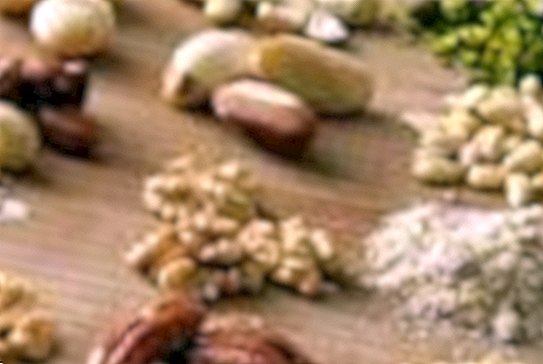Uncooked: All about nuts

cashews

Cashew kernels are actually the seeds of cashew apples: these yellow or red fruits grow on trees up to twelve meters high. After harvesting, the cashews are dried as a whole and peeled by machine. Main cultivation areas are India, China Brazil and East Africa.
Cashews taste very mild and pleasant. They contain water-soluble vitamin B1, naturally unsaturated fatty acids, vegetable proteins, fiber and minerals such as sodium, potassium, calcium, phosphorus and niacin.
100 g cashew kernels have 568 kcal and 42 g fat.
Macadamia

Macadamia nuts come only peeled in the trade - their shell is so hard that you can crack them only with special tools. Most macadamia plantations are in Australia, South Africa and Hawaii.
Macadamia nuts have a particularly favorable composition of monounsaturated and polyunsaturated fatty acids, which has a positive effect on the cholesterol level. In addition, the slightly more than hazelnut-sized fruits contain a lot of protein, vitamin B, calcium, iron and phosphorus.
100 g macadamia nuts have 676 kcal and 73 g fat.
pistachios

The tall pistachio trees are well over a hundred years old and only deliver the green yummy nuts every two years. The best come from Sicily, but also Turkey and California are export countries. A quality feature for good pistachios is their bright green color. Pistachios need to laugh, says a Persian proverb - they are only good when their shell is open.
100 g pistachios have 574 kcal and 52 g fat.
Brazil nuts

The giant trees can grow up to 60 meters high and grow mainly in the Amazon. The trees need 30 years to mature until the first fruits that are the size of coconuts.
The elongated seed kernels, the later Brazil nuts, are taken from the shells and dry under the sun. Brazil nuts are very rich in fat and quickly become rancid.
100 grams of Brazil nut kernels have 660 kcal and 67 g fat.
pine nuts

The elongated shiny pine nuts are the seeds of the pine tree, a pine species that grows in the Mediterranean. Therefore, there are also many Italian recipes with pine nuts - the most famous is the classic Pesto Genovese. The seeds are taken from the pine cones.
Pine kernels quickly become rancid due to their high fat content - also because they do not have a protective skin coat like almonds or walnuts. They become more durable when they are briefly roasted in the pan without fat.
100 g of pine nuts have 575 Kcal and 51 g fat.
hazelnuts

A nut that does not have to travel far to our kitchens: Hazelnuts grow all over Europe, even on our doorstep. Large quantities are also cultivated in the USA. Hazelnuts are harvested here in autumn. You can buy them as whole nuts, nut kernels, planed, ground and chopped hazelnuts. Nougat and hazelnut cream are based on hazelnuts.
To determine the freshness of the nuts, shake them. If they do not rattle, they are fresh.
100 g of hazelnut kernels have 636 kcal and 62 g fat.
walnuts

50 grams of walnuts cover an adult's daily requirement for omega-3 fatty acids, so they deliver more than, say, salmon. They also contain folic acid. Walnut trees grow in Europe, especially in the Mediterranean, where they are harvested in the fall. Most nuts come from the USA.
The large nuts are available all year round in shell and peeled as halves. Milled, they are virtually not offered. Walnuts are versatile: they taste particularly good with cheese, salad and cake. And deliver a lot of health with little effort - it is said that only five walnuts a day are enough to keep the arteries free!
100 g of walnut kernels have 654 kcal and 63 g fat.
peanuts

They are the only nuts in our selection that do not grow on trees and bushes, but under the ground. Botanically, peanuts are not nuts, but legumes.
Most peanuts come from America. Primarily roasted and salted as a snack, they are less used for baking. They taste slightly bitter in the raw state. Therefore, the peanuts in the shell are always dried or roasted. Much of the harvest flows into edible oil production and peanut butter, which is particularly popular in America. Of all nuts, peanuts contain the most magnesium.
100 g peanuts have 561 kcal and 48 g fat.
pecans

In shape and size, pecans are similar to walnuts. They also have an uneven surface. Pecans grow on very tall, up to 300-year-old hickory trees in southern North America.The high-fat nuts used to be the staple diet of the Indians.
With us the pecan nut is not very common, before Christmas you get it in the supermarket. But she is always present in the American Pecan Pie, as well as in many American cookie recipes.
100 g pecans have 692 kcal and 72 g fat.
almonds

Almonds are the oldest nuts in the world - and the most common. They love their pretty flowers, they like them whole, peeled, donated, ground and chopped. The up to ten-meter-high trees grow in Europe and California.
Almonds are very versatile: they are needed for marzipan, almond oil is used both in the kitchen, as well as in cosmetics, they nibble as smoke and salted almonds, on the fair as roasted almonds. We distinguish sweet and bitter almonds.
Bitter almonds contain a blue-acid poison and are not suitable for consumption. You just need them for flavoring. And beware: even eating five raw bitter almonds can be fatal to sensitive people and children.
100 g almonds contain 569 kcal and 54 g fat.










